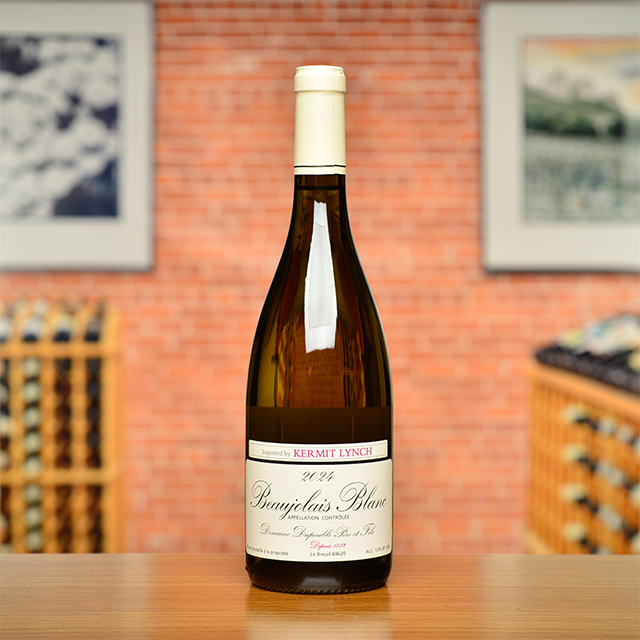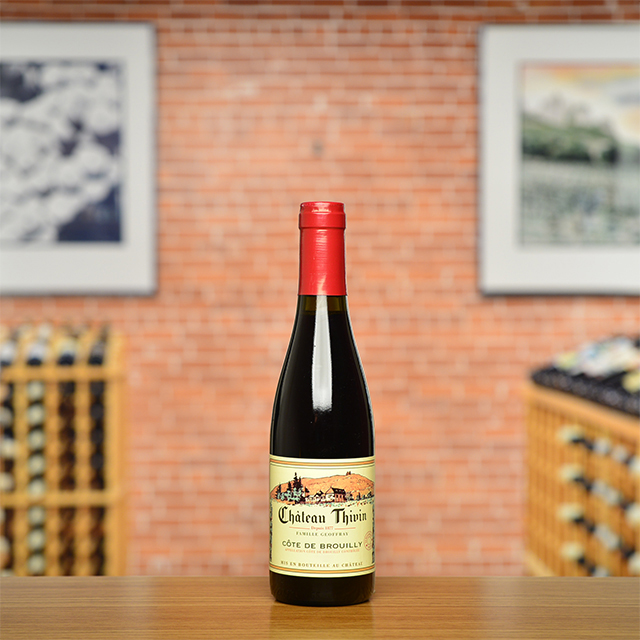Notify me
2015 Beaujolais
Domaine Dupeuble
Have you ever noticed that drinking wine at lunchtime is not much of “a thing” in the States? The French might pop open a bottle with a simple caprese salad, while we Americans save wine for more special occasions, like dinner. This Beaujolais from Dupeuble is bright, elegant, and approachable, with the added bonus of being so affordable it could become your house wine. Chez nous, this is the bottle I open when I’m not sure what will go best. It always shines, even at lunch with the humblest tomatoes and mozzarella.
—Emily Spillmann
| Wine Type: | red |
| Vintage: | 2015 |
| Bottle Size: | 750mL |
| Blend: | Gamay |
| Appellation: | Beaujolais |
| Country: | France |
| Region: | Beaujolais |
| Producer: | Domaine Dupeuble |
| Winemaker: | The Dupeuble Family |
| Vineyard: | 50 - 100 years, 42 ha |
| Soil: | Granite, Clay, Limestone |
| Aging: | Fermented naturally (carbonic maceration) and aged in cement and stainless steel |
| Farming: | Lutte Raisonnée |
| Alcohol: | 13.5% |
More from this Producer or Region

2024 Côte de Brouilly
France | Beaujolais
Brambly and mineral, this bottling exudes both the convivial charm of Gamay and the crunchy intensity of the Côte de Brouilly.

2024 Beaujolais Blanc
France | Beaujolais
Do not miss this outstanding, value-driven Chardonnay from one of our most beloved French domaines.

2021 Brouilly
France | Beaujolais
A generous dash of plump, sun-ripened fruit enveloping a granite core.

2023 Fleurie
France | Beaujolais
Light and living, charged with herbs, cranberry, and strawberry.

2024 Beaujolais MAGNUM
France | Beaujolais
This Beaujolais offers the drinkability of the most effusive Morgons with the frankness of a chiseled Moulin-à-Vent.

2024 Morgon
France | Beaujolais
The domaine’s flagship bottling, crafted from vines averaging sixty years old; inviting aromatics, succulent flesh, juicy finish.

2024 Beaujolais
France | Beaujolais
Tangy, thirst-quenching Gamay from a family that has been making Beaujolais for over 500 years.

2024 Régnié “Grain & Granit”
France | Beaujolais
Here is a rich, bold Régnié, saturated with luscious fruit and earthy spice.

2024 Côte de Brouilly HALF BOTTLE
France | Beaujolais
Loaded with wild fruit, spice, and crunchy minerality, Thivin's Côte de Brouilly marries to perfection with soulful cuisine.

2023 Chénas “Chassignol”
France | Beaujolais
A finessed, mineral-driven beauty from hundred-year-old vines at the highest point in Chénas.
About The Producer
Domaine Dupeuble
About The Region
Beaujolais

After years of the region’s reputation being co-opted by mass-produced Beaujolais Nouveau and the prevalence of industrial farming, the fortunes of vignerons from the Beaujolais have been on the rise in the past couple of decades. Much of this change is due to Jules Chauvet, a prominent Beaujolais producer who Kermit worked with in the 1980s and arguably the father of the natural wine movement, who advocated not using herbicides or pesticides in vineyards, not chaptalizing, fermenting with ambient yeasts, and vinifying without SO2. Chief among Chauvet’s followers was Marcel Lapierre and his three friends, Jean Foillard, Guy Breton, and Jean-Paul Thévenet—a group of Morgon producers who Kermit dubbed “the Gang of Four.” The espousal of Chauvet’s methods led to a dramatic change in quality of wines from Beaujolais and with that an increased interest and appreciation for the AOC crus, Villages, and regular Beaujolais bottlings.
The crus of Beaujolais are interpreted through the Gamay grape and each illuminate the variety of great terroirs available in the region. Distinguishing itself from the clay and limestone of Burgundy, Beaujolais soils are predominantly decomposed granite, with pockets of blue volcanic rock. The primary vinification method is carbonic maceration, where grapes are not crushed, but instead whole clusters are placed in a tank, thus allowing fermentation to take place inside each grape berry.
Much like the easy-going and friendly nature of many Beaujolais vignerons, the wines too have a lively and easy-drinking spirit. They are versatile at table but make particularly good matches with the local pork sausages and charcuterie. Though often considered a wine that must be drunk young, many of the top crus offer great aging potential.
More from Beaujolais or France
2024 Beaujolais Blanc
Domaine Dupeuble France | Beaujolais
2018 Brouilly
Alex Foillard France | Beaujolais
2024 Côte de Brouilly
Château Thivin France | Beaujolais
2024 Fleurie “Les Moriers”
Domaine Chignard France | Beaujolais
2023 Moulin-à-Vent “Sous la Roche”
Domaine Thillardon France | Beaujolais
2024 Côte-de-Brouilly
Nicole Chanrion France | Beaujolais
2024 Morgon “La Roche Pilée”
Jean-Paul et Charly Thévenet France | Beaujolais
2024 Beaujolais
Domaine Dupeuble France | Beaujolais
2024 Brouilly “Reverdon”
Château Thivin France | Beaujolais
2023 Chénas “Vibrations”
Domaine Thillardon France | Beaujolais
2025 Beaujolais Nouveau
La Sœur Cadette France | Beaujolais
2022 Régnié
Guy Breton France | Beaujolais
2024 Beaujolais Blanc
Domaine Dupeuble France | Beaujolais
2018 Brouilly
Alex Foillard France | Beaujolais
2024 Côte de Brouilly
Château Thivin France | Beaujolais
2024 Fleurie “Les Moriers”
Domaine Chignard France | Beaujolais
2023 Moulin-à-Vent “Sous la Roche”
Domaine Thillardon France | Beaujolais
2024 Côte-de-Brouilly
Nicole Chanrion France | Beaujolais
2024 Morgon “La Roche Pilée”
Jean-Paul et Charly Thévenet France | Beaujolais
2024 Beaujolais
Domaine Dupeuble France | Beaujolais
2024 Brouilly “Reverdon”
Château Thivin France | Beaujolais
2023 Chénas “Vibrations”
Domaine Thillardon France | Beaujolais
2025 Beaujolais Nouveau
La Sœur Cadette France | Beaujolais
2022 Régnié
Guy Breton France | Beaujolais
Kermit once said...

Kermit once said...
For the wines that I buy I insist that the winemaker leave them whole, intact. I go into the cellars now and select specific barrels or cuvées, and I request that they be bottled without stripping them with filters or other devices. This means that many of our wines will arrive with a smudge of sediment and will throw a more important deposit as time goes by, It also means the wine will taste better.
















